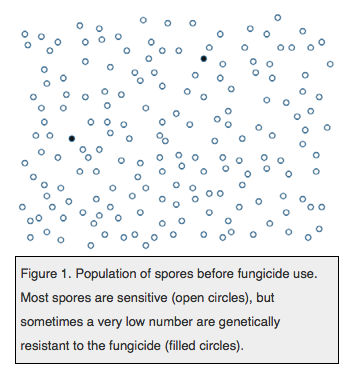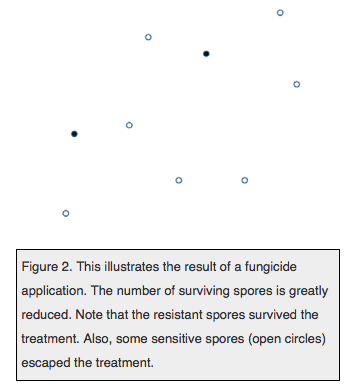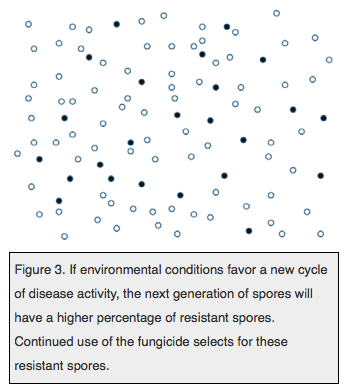Fungicides are important tools in modern crop production. Unfortunately, one of the risks of using these products is that fungi sometimes develop resistance to them. Resistance development is a concern because the products may become less effective—or even useless—for controlling resistant pathogens and pests.
This is a concern for all pesticides, including fungicides, insecticides, and herbicides. This is the first in a series of short articles intended to help understand this process better.
The basic process of resistance development is illustrated in Figures 1-3, as follows:
Figure 1: Resistance can only develop in spore populations where there is the genetic potential to resist the disease (represented by the filled circles in the figures). Normally, resistant spores occur at extremely low numbers: one in a million to one in a billion. But that is all it takes to start the process.
Figure 2: When a fungicide spray is applied, many of the fungal spores are killed. This is the objective of using a fungicide, of course. However, resistant spores can survive the treatment. Note that some of the sensitive spores also survived, because they “escaped” the fungicide treatment.
This means that they were lucky enough to be in a microsite that was not treated with fungicide. (This can result from incomplete spray coverage, for example.)
Figure 3: If environmental conditions favor continued disease activity, the surviving spores grow and produce a new crop of spores. Note that this new crop of spores has a higher percentage of resistant spores, because the resistant spores preferentially survived the fungicide treatment (Figures 1-2).

|

|

|
In a nutshell, the development of resistance is a form of evolution, and it happens if two conditions are in place:
- Genetic variability: The fungus has spores with the genes necessary to resist the toxin.
- Selection: The toxin is used repeatedly.
The first of these conditions—the genetic potential—is out of human control (for the most part). The mutant either exists in the field or does not. The second condition—selection—is what happens when we apply the at-risk fungicide.
Our use of the fungicide selects for those spores that can survive the presence of the toxin. That condition is clearly under human control. It is a natural outcome of the use of at-risk fungicides.






Post a comment
Report Abusive Comment